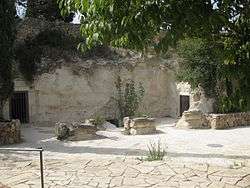Cave of Nicanor
Coordinates: 31°47′35.48″N 35°14′41.56″E / 31.7931889°N 35.2448778°E
.jpg)


The Cave of Nicanor is an ancient burial cave located on Mount Scopus in Jerusalem, Israel. Excavations in the cave discovered an ossuary referring to "Nicanor the door maker." [1] The cave is located in the National Botanic Garden of Israel on the grounds of the Mount Scopus campus of the Hebrew University of Jerusalem.
History
In 1903, John Gray Hill discovered the family tomb of Nicanor of Alexandria in a field just north of his house. Gladys Dickson brought it to the attention of the Palestine Exploration Fund. Charles Simon Clermont-Ganneau, a French diplomat and orientalist, examined it, publishing his conclusions in the Palestine Exploration Fund Quarterly Statement. Later that year Dickson published a detailed report on the tomb complex illustrated with plans by R.A. Stewart Macalister. Gray Hill gave the ossuary to the Palestine Exploration Fund, which transferred it to the British Museum.[2]
Nicanor belonged to a wealthy Alexandrian Jewish family. He is mentioned in the works of the Roman Jewish historian Josephus and the Talmud as the donor of the bronze doors of the Court of the Women in the Second Temple in Jerusalem. This fact is also inscribed in Greek on his ossuary: ‘Bones of the family of Nicanor the Alexandrian who made the gates.’ The ossuary is engraved with geometric patterns, with rough red-painted decoration on the lid. The inscriptions appear at one end.
This form of burial cave is typical of the Second Temple period. Four burial halls of burial, each with a number of niches. In the passages between the halls rock depressions indicate that the entrances were decorated with stone slabs, a phenomenon unique to this cave. Outside the cave is a hewn rectangular courtyard. A fifth burial cave not linked to the rest of the hall, opens to the right of the front yard, on the eastern side of the courtyard.
Byzantine pottery found at the bottom of the shafts in the yard and two crosses engraved on the wall of the main room, show that use of the cave continued until the Byzantine period.
The architectural plan of the cave, the artistic style, and finds within it, allow the cave to be dated to the middle of first century CE.
National Pantheon of Israel

In 1934, the remains of Leon Pinsker from Odessa were reburied in the Nicanor cave at the initiative of Menachem Ussishkin, who envisaged a national pantheon on Mt. Scopus. However, the only other person buried there was Ussishkin himself, who died in 1941. A national leaders plot was established on Mount Herzl after the founding of the state in 1948, in part because Mount Scopus became an enclave in Jordanian-occupied territory.
See also
References
- ↑ Clermont-Ganneau, "Archeological and epigraphic notes on Palestine," Palestine Exploration Fund Quarterly Statement, 1903, pp.125-131; Gladys Dikson, "The tomb of Nicanor of Alexandria," Palestine Exploration Fund Quarterly Statement, 1903, pp.326-332
- ↑ Nicanor sarcophagus in the British Museum
External links
| Wikimedia Commons has media related to Tomb of Nicanor. |